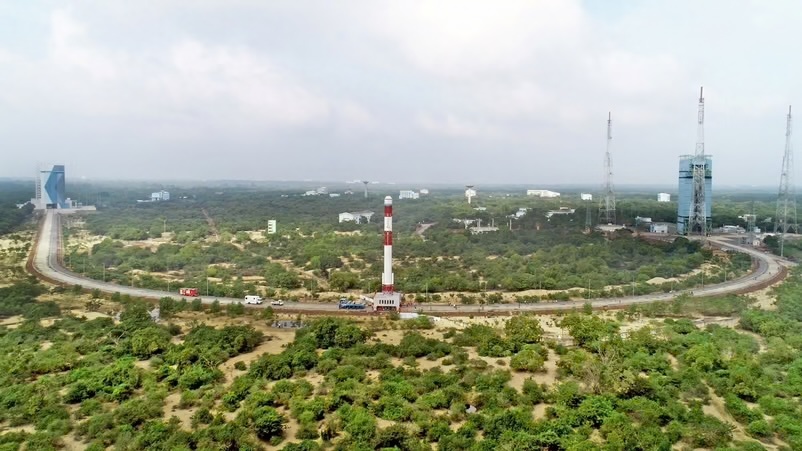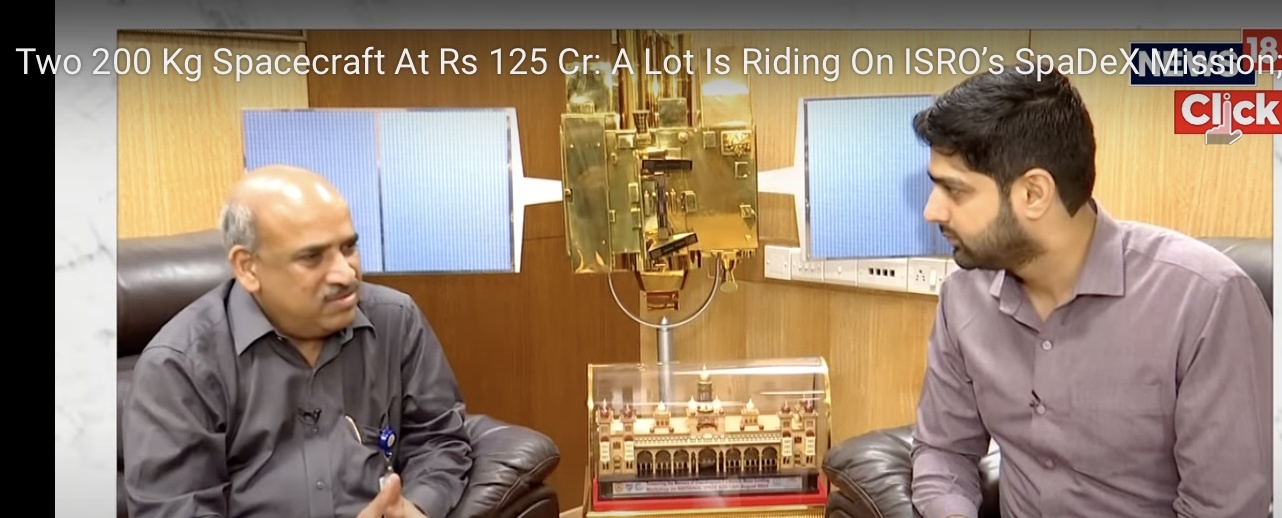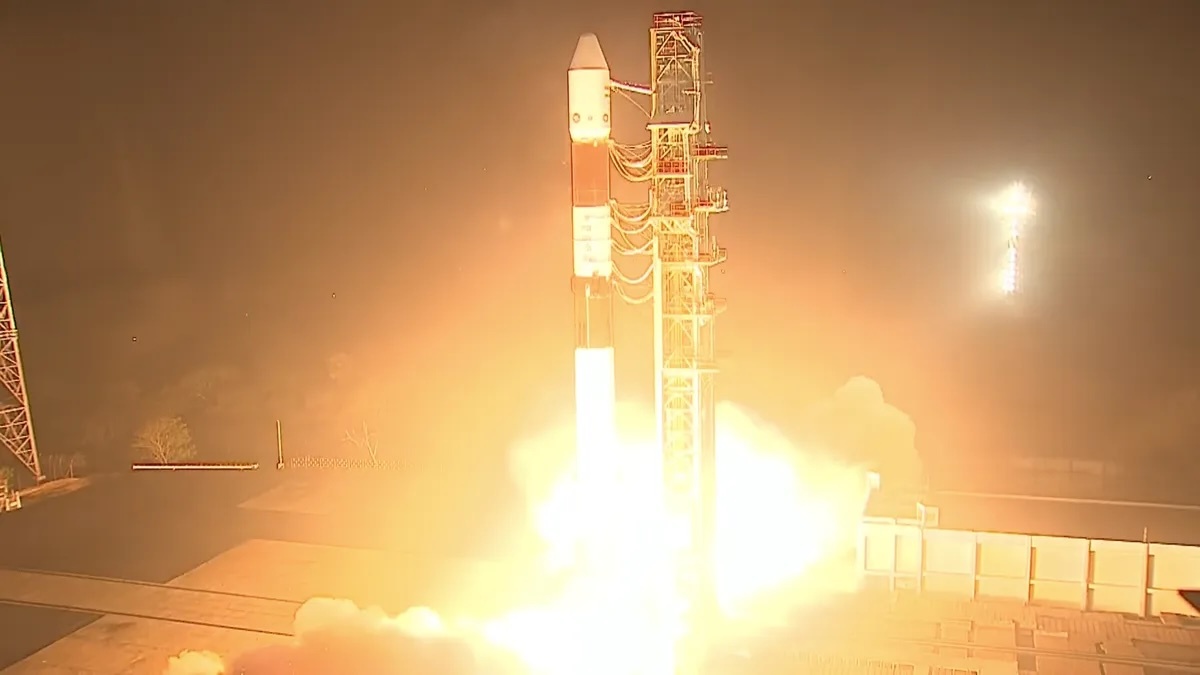23.12.2024
ISRO rolls out PSLV rocket, to launch SpaDex mission on 26 Dec
SpaDex is a technology demonstrator for in-orbit docking. The capability is crucial for future Gaganyaan missions.

New Delhi: ISRO is gearing up to launch its final spaceflight for 2024, and has rolled out its workhorse rocket, the Polar Satellite Launch Vehicle (PSLV) to the First Launch Pad at its spaceport in Sriharikota. The passengers on board are a pair of small satellites that will demonstrate the technology necessary for rendezvous, docking and undocking, capabilities necessary for the Chandrayaan 4 sample return mission, assembling and operating the Bharatiya Antariksh Station (BAS) and eventually landing a human on the lunar surface using domestic hardware. Such in-space docking is necessary when all the hardware required for a particular mission cannot be deployed on a single rocket, such as the ambitious Chandrayaan 4 mission.
The SpaDex mission consists of two spacecraft, SDX01 which is the Chaser, and SDX02 which is the Target. Each of the spacecraft weigh about 220 KG and will be injected into a circular orbit at an altitude of 470 kilometres. The precision of the PSLV will be used to give a small relative velocity between the Target and Chaser spacecraft at the time of the deployment. This will allow the Target spacecraft to move between 10 and 20 kilometres away from the Chaser spacecraft within a day. The onboard propulsion system will be used by the Target spacecraft to stabilise the distance using a drift arrest manoeuver.
Mission to continue for two years after docking experiment
The Chaser will then approach the Target slowly, progressively reducing the distance till it docks with the spacecraft. ISRO intends to test a number of novel technologies, including electrical power transfer between the two satellites, before undocking the two satellites to operate their expected payloads, for a period of two years. The small size of the spacecraft makes the docking challenging. After undocking, the two spacecraft will conduct surveillance and radiation experiments. A number of ISRO facilities around the country have worked together to realise the mission. ISRO is aiming to launch the PSLV-C60 mission on 26 December.
Quelle: news n9ne
----
Update: 24.12.2024
.
Isro to launch 24 experiments to space with PSLV Spadex mission
India's space program advances as the Indian Space Research Organisation (Isro) prepares to launch 24 cutting-edge scientific experiments aboard PSLV Orbital Experiment Module-4 (POEM-4).
In Short
- Mission payloads include Isro's projects and private collaborations
- 14 Isro payloads focus on robotics, sensors, and space science
- 10 private payloads cover biology, propulsion, and AI
The Indian Space Research Organisation (Isro) is all set for a groundbreaking mission to deploy as many as 24 scientific experiments into space aboard the PSLV Orbital Experiment Module-4 (POEM-4) under the SpaDeX mission.
These payloads include a mix of projects from Isro's own research facilities, as well as contributions from private entities and academia, showcasing India's growing collaborative prowess in space technology.
The mission will carry 14 payloads developed by ISRO/Department of Space (DOS) centres, alongside 10 contributions from non-government entities (NGEs), including academic institutions and start-ups facilitated through the Indian National Space Promotion and Authorisation Centre (IN-SPACe).
ISRO PAYLOADS
Isro's payloads will focus on advanced robotics, sensor technology, and space science experiments, such as:
- Robotics: The Walking Robotic Arm using inch-worm motion (developed by IISU) and a Debris Capture Robotic Manipulator (VSSC).
- Sensor Technologies: Gradient Control Reaction Wheel Assembly and a Multi-Sensor Inertial Reference System featuring in-house gyroscopes (both by IISU), and MEMS-based High Angular Rate Sensors (VSSC).
- Innovative Electronics: The Lead Exempt Experimental System (VSSC) and a Highly Configurable Onboard Common Controller (SPL).
- Space Science Initiatives: Experiments such as the Electron Temperature Analyser and IDEA-V2 suite for studying electron density and neutral winds (SPL), PLASDEM software for ionospheric studies (a collaboration between SPL and IISU), and orbital plant studies through the Compact Research Module (VSSC).
- Other Notables: Laser Firing and Initiation Pyro Units (VSSC) and the PILOT-G2 payload (IIST).
PROJECTS OF STARTUPS & ACADEMIA
The 10 payloads from NGEs consist of the study of various spectra of science and engineering, such as:
- Biological Studies: Growth of plant callus in microgravity (Amity University, Mumbai) and growth kinetics of gut bacteria (RV College of Engineering, Bengaluru).
- Green Propulsion: Novel propulsion systems using green monopropellants (Bellatrix Aerospace, Bengaluru) and hydrogen peroxide-based thrusters (Manastu Space Technologies, Mumbai).
- Space Imaging and Communication: Synthetic Aperture Radar (SAR) imaging (GalaxEye Space Solutions, Bengaluru) and in-orbit SAR demonstrations in CubeSat form factor (Piersight Space, Ahmedabad).
- Sensor Technologies: MEMS-based Inertial Measurement Units and ARM-based microcontrollers for attitude measurement (MIT-WPU, Pune).
- Satellite Communication: Amateur Radio Satellite services (SJC Institute of Technology, Karnataka, in collaboration with UPARC).
- AI in Space: India’s first Artificial Intelligence lab in space (TakeMe2Space, Hyderabad).
THE SPADEX MISSION
Meanwhile, the space agency, in a recent statement, the SpaDeX mission has been integrated and moved to the first launch pad of Satish Dhawan Space Centre, Sriharikota. This mission is intended to develop and demonstrate a technology needed to dock and undock spacecraft in space, apart from other things.
The SpaDeX mission is a cost-effective technology mission for the demonstration of 'in-space docking' using two small spacecraft launched by The Polar Satellite Launch Vehicle (PSLV).
Quelle: INDIA TODAY
----
Update: 26.12.2024
.
Two 200 Kg Spacecraft At Rs 125 Cr: A Lot Is Riding On ISRO’s SpaDeX Mission; Here's Why | Exclusive
The spacecraft has been designed and built by ISRO’s UR Rao Satellite Centre in Bengaluru. The centre’s director M Sankaran spoke exclusively with CNN-News18, explaining the significance of the experiment

The Indian Space Research Organisation is ending 2024 on a high with the launch of the SpaDeX Mission scheduled for December 30 at 9.58 pm from Sriharikota. It is a mission for the demonstration of in-space docking using two small spacecraft launched by PSLV. This technology is essential for India’s space ambitions, such as the lunar sample return mission, building and operating Bharatiya Antariksh Station (BAS), and a crewed mission to the moon.
The spacecraft has been designed and built by ISRO’s UR Rao Satellite Centre in Bengaluru. The centre’s director M Sankaran spoke exclusively with CNN-News18, explaining the significance of the experiment.
With SpaDeX, India is marching towards becoming the fourth country in the world to have space docking technology. “Docking basically is making two independent objects come together and join together and behave as if they are a single object. It is important for crewed missions to the moon or other planets; it’s not possible to achieve without docking technology. Even the Saturn 5 mission, which had a capacity of 150 tonnes, couldn’t do it without docking. For India, it is even more important because we don’t want to spend like Saturn 5 which was developed with the sole purpose of going to the moon and coming back. What is the use of that vehicle after that mission? That vehicle was retired after the Apollo flights. We are not going to spend money on a very high-capacity rocket just for one or two missions. We will not have any use of that rocket for anything else," explained Sankaran.
ISRO’s launch vehicle has half or 1/3rd the capacity of Saturn. But by having this docking capability, ISRO plans to achieve what Saturn 5 or Starship plans to do, while using a smaller launch vehicle. Launch vehicles take up a big part of the budget in any space mission.
How will space docking take place?
Two spacecraft, named Chaser and Target, will be released in the same orbit but with some distance between them. Then ISRO will attempt to dock and undock these spacecraft.
“We will allow two satellites in the same orbit to get an inter-satellite distance of 10-20 km. Then we will give relative velocity to one satellite so that both are at the same velocity and maintain the same distance between them and go like a pair together. By increasing the relative velocity, we can increase or decrease the distance respectively. In the next set of manoeuvres we will progressively reduce the distance between them. From 20 km, we will bring the distance to 10 metres and 5 metres and allow it to dock. The whole activity will happen in 10-15 days from the time of the launch," said M Sankaran.
Importance of SpaDeX
A successful SpaDeX demonstration will not just show the world that India has mastered the art of space docking but will also play a big role in ISRO’s future ambitious missions. This mission will be a forerunner for autonomous docking needed for future lunar missions like Chandrayaan 4 without the support of GNSS from Earth. “Chandrayaan 4 has been designed in such a way that docking is an essential technology available for that. Sapdex will feed into the actual realisation of Chandrayaan 4. This demonstration will give us confidence. Docking for Chandrayaan-4 will happen in a different kind of orbit. We have developed a number of sensors, algorithms, and software that will be validated during SpaDeX and they will be updated for the requirements of Chandrayaan 4," explained Sankaran.
India’s ambitious goal of building a space station will also be dependent on ISRO demonstrating the docking technology. “For Bharatiya Antariksh Station, different modules need to be launched independently, and they have to be docked together to become a large space station. Whether it’s the crew going to the space station or sending supplies, all of them need a craft that can dock. It is an essential requirement for all this. It’s a mission enabler for many of these future missions," Sankaran said.
Economical but challenges galore
ISRO is known for its economical missions and for not undertaking unnecessary trial missions. The same holds true for mastering docking technology. The Indian space agency has spent around 125 crore to build the two spacecraft and related instruments and is likely to spend another 250 crore on the launch vehicle.
However, the challenge for the satellite team was building small spacecraft and managing the smaller inertia. “The biggest challenge was to do it at a small scale, both in terms of money and physical shape. We cannot spend Rs 1,000-2,000 crore. We spent Rs 125 crore on this mission, plus the launch vehicle cost. The challenge of docking using a very small spacecraft is that the inertia of the spacecraft is very small. Even a small disturbance will make the satellite move away. Low mass and low inertia mean a small force can disturb it. It’s a 200 kg satellite. If we do this successfully, it’s a cakewalk to dock with heavier craft like for BAS," said the director.
And once again, he said, ISRO is all set to make India proud and grab the attention of the whole world. “The success of Chandrayaan 3 has made people turn back and look at ISRO and India with renewed interest. The ability of India and Indians will be once more demonstrated to the whole world," said a confident Sankaran.
Quelle: NEWS18
----
Update: 30.12.2024
.
India launches 2 SpaDeX satellites on ambitious space docking test for future moon mission, space station



 Two spacecraft, named Chaser and Target, will be released in the same orbit but with some distance between them. Then ISRO will attempt to dock and undock these spacecraft. Images/News18
Two spacecraft, named Chaser and Target, will be released in the same orbit but with some distance between them. Then ISRO will attempt to dock and undock these spacecraft. Images/News18